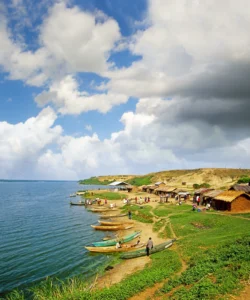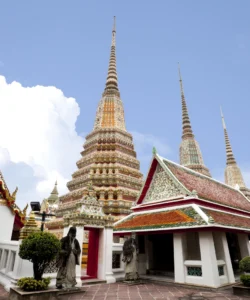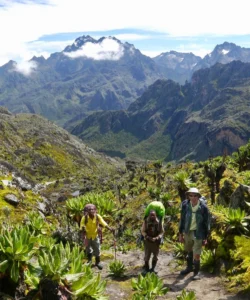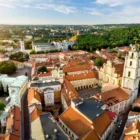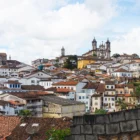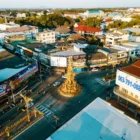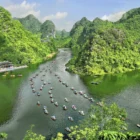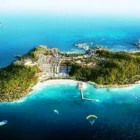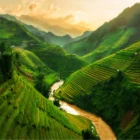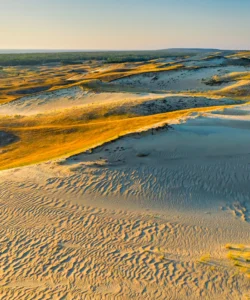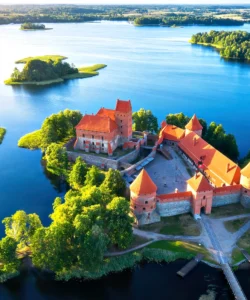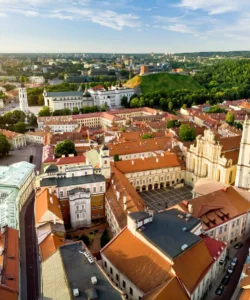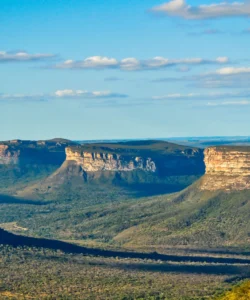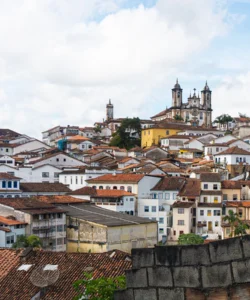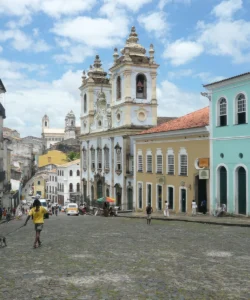Mount Elgon, an extinct shield volcano straddling the border of Uganda and Kenya in East Africa, is a majestic and ancient geological wonder. While often overshadowed by its taller East African counterparts like Kilimanjaro and Mount Kenya, Mount Elgon holds a unique distinction: it contains one of the largest intact calderas in the world. This massive, bowl-shaped depression at its summit, coupled with its unique afro-montane vegetation, numerous caves, and waterfalls, makes it a captivating destination for trekkers and nature enthusiasts seeking an off-the-beaten-path adventure.
Name: Mount Elgon Caldera. The mountain itself is called Mount Elgon. It’s known as “Masaba” by the Bagisu (Bamasaba) people of Uganda, who consider it the embodiment of their founding father.
Address: Mount Elgon National Park, Northeastern Uganda (and Western Kenya). The main Ugandan trailheads are Nyakalengija (for the Central Circuit) and Kilembe (for the Kilembe Trail), both near Kasese town. Correction: The main Ugandan trailheads are Sasa (Budadiri), Sipi (Kapkwai), and Piswa (Kapkwata).
How to get there:
Reaching Mount Elgon, involves a significant international journey followed by domestic travel within Uganda:
- From Entebbe/Kampala (Uganda) to Mount Elgon National Park:
- By Road (Common for Treks): Mount Elgon is located in eastern Uganda, approximately 230-260 km (140-160 miles) northeast of Kampala. The drive takes around 4-6 hours, usually to the town of Mbale (the gateway to the Ugandan side of the park). A sturdy 4×4 safari vehicle is often recommended, especially for the last kilometers to the trailheads, which can be dirt roads and slippery when wet.
- Routes: The main trekking routes on the Ugandan side are the Sasa Trail (most direct but steepest), Sipi Trail (starting from Kapkwai Forest Exploration Center), and Piswa Trail (longest but most gentle).
- By Air (Less Common for Elgon): While there are airstrips in Uganda, reaching Mount Elgon by domestic flight is less common than driving, given its eastern location and the road infrastructure.
- By Road (Common for Treks): Mount Elgon is located in eastern Uganda, approximately 230-260 km (140-160 miles) northeast of Kampala. The drive takes around 4-6 hours, usually to the town of Mbale (the gateway to the Ugandan side of the park). A sturdy 4×4 safari vehicle is often recommended, especially for the last kilometers to the trailheads, which can be dirt roads and slippery when wet.
Best Time to Visit:
Mount Elgon National Park and its caldera are accessible year-round. However, the drier seasons (December to March and June to August) are generally preferred for trekking. During these periods, trails are less muddy, and there’s a higher chance of clear skies for summit views and seeing into the caldera. Even in dry seasons, rain is possible, so prepare for all weather conditions.
Operating Hours and Entrance Fee:
- Operating Hours: Mount Elgon National Park is generally open daily from 7:00 AM to 7:00 PM. Trekking requires a guide and typically starts early in the morning.
- Entrance Fee (for Foreign Non-Residents):
- Park Entry Fee: US$40 per person per day.
- Mountaineering Permits: Separate fees apply for trekking permits, UWA ranger guides (mandatory for all treks), porters (optional but highly recommended), and accommodation in basic huts or campsites along the trekking routes. These costs are usually part of a multi-day trekking package arranged through licensed tour operators.
- Note: Fees are subject to change by the Uganda Wildlife Authority (UWA). It’s crucial to book multi-day treks well in advance.
Landscape and Architecture:
Mount Elgon’s “architecture” is primarily its vast and varied natural volcanic landscape, shaped by millions of years of geological activity and erosion:
- Massive Extinct Shield Volcano: Mount Elgon is an ancient, extinct shield volcano, meaning it has a broad base (80 km in diameter) and relatively gentle slopes compared to steeper stratovolcanoes. It was once Africa’s highest mountain (estimated over 5,800m) but has been reduced to its current height (Wagagai Peak at 4,321m) by millennia of erosion.
- The Caldera: The defining feature. Mount Elgon boasts one of the largest intact calderas in the world, spanning approximately 40 km² (or 8 km wide). This vast depression was formed when the volcano’s magma chamber emptied and the overlying cone collapsed. The caldera floor is often lush and green, sometimes containing small crater lakes and hot springs.
- Five Major Peaks (Caldera Rim): The caldera is encircled by a jagged rim with several high peaks: Wagagai (4,321m, Uganda), Sudek (4,303m, Uganda/Kenya border), Koitobos (4,222m, Kenya), Mubiyi (4,210m, Uganda), and Masaba (4,161m, Uganda).
- Stratified Vegetation Zones: Like other East African mountains, Elgon exhibits distinct altitudinal vegetation zones:
- Lower Slopes/Farmlands: Cultivated areas transitioning into natural grassland.
- Montane Forest: Dense evergreen forests with rich biodiversity.
- Bamboo Zone: Thick bamboo forests.
- Heather Zone: Moorlands dominated by giant heathers draped in moss.
- Afro-Alpine Zone: Higher altitudes with unique hardy plants like giant lobelias and groundsels, though less prominent than in the Rwenzoris or Mt. Kenya.
- Caves: Mount Elgon is famous for its numerous caves, some of which are very deep (e.g., Kitum Cave in Kenya, known for salt-licking elephants). On the Ugandan side, caves like Kapkwai and Khauka can be explored.
- Waterfalls and Gorges: The mountain is a crucial water catchment area, with rivers cascading down its slopes, forming beautiful waterfalls (like the famous Sipi Falls, just outside the park, or Chebonet Falls within). Deep gorges like Suam Gorge are also prominent features.
- Hot Springs: Hot springs are found within the caldera, particularly at the start of Suam Gorge, offering a unique opportunity for trekkers to relax.
- Simple Trekking Huts/Campsites: Basic overnight huts and designated campsites with water sources and latrines are available along the trekking routes. These simple structures are the only human “architecture” within the higher mountain environment.
- Transboundary Park: The mountain is protected by two national parks: Mount Elgon National Park (Uganda) and Mount Elgon National Park (Kenya), forming an extensive transboundary conservation area.
What makes it famous:
Mount Elgon is famous for:
- World’s Largest Intact Caldera: This is its primary and most significant geological claim to fame, offering a vast, often misty and mysterious, internal landscape to explore.
- Ancient Extinct Volcano: As one of East Africa’s oldest and largest extinct volcanoes, its geological history is profound.
- Unique Afro-Montane Ecosystem: Its diverse vegetation zones, from dense montane forests to unique afro-alpine moorlands, support a rich biodiversity.
- Less Crowded Trekking Alternative: Compared to the more popular (and often crowded) treks of Kilimanjaro or Mount Kenya, Elgon offers a milder climate, lower elevation (making altitude sickness less severe), and a less summit-oriented approach, providing a more serene and uncrowded mountaineering experience.
- Cultural Significance: It holds deep cultural importance for the local Bagisu and Sabiny communities, who have strong ancestral ties and traditions linked to the mountain.
- Elephant Caves: While more prominent on the Kenyan side (Kitum Cave), the phenomenon of elephants venturing deep into caves to lick salt is a unique aspect of Elgon’s wildlife.
- Water Catchment: It is a vital water source for numerous rivers, including those that flow into Lake Victoria and Lake Turkana.
- Stunning Scenery: Offers breathtaking panoramic views of vast plains, rugged mountains, and lush valleys from its peaks and caldera rim.
Differences from some other wonders:
Mount Elgon Caldera distinguishes itself from other famous mountains and natural wonders in several key ways:
- Largest Intact Caldera: Its unrivaled status as one of the world’s largest intact calderas is its most prominent and specific geological differentiator from other volcanoes or mountain ranges, many of which may have smaller or less well-preserved calderas.
- Non-Glaciated Summit (Currently): While it was once much higher and had glaciers, its current state as a high mountain with an immense caldera but without major permanent snow or ice fields (compared to Rwenzoris, Kilimanjaro, or Mount Kenya) makes it a distinct type of high-altitude trekking experience, focusing more on the caldera, caves, and unique flora than on glacier crossings.
- Archaeological Significance (Caves): The presence of numerous large caves, some with evidence of ancient human habitation and unique wildlife interactions (like salt-licking elephants), gives it a distinct archaeological and biological cave system that is a specific draw, unlike many other mountains.
- Focus on the Internal Crater (Caldera): The ultimate goal of an Elgon trek is often described as the descent into and exploration of the vast caldera itself, rather than just summiting a single peak. This internal exploration of a massive volcanic crater makes it a unique mountaineering objective.
- Less Technical Climb: While still a serious trek, climbing Mount Elgon (especially Wagagai Peak) is generally considered less technically challenging and requires no specialized mountaineering equipment compared to the more arduous and technical climbs of the Rwenzoris or Kilimanjaro, making it more accessible to experienced hikers rather than mountaineers.
- Transboundary Wilderness: Its shared status between Uganda and Kenya as a protected area encourages cross-border conservation efforts and offers potential for varied trekking routes between the two countries.
In essence, Mount Elgon Caldera is a magnificent and unique wonder, an ancient volcanic giant that offers an unparalleled trekking experience into one of the world’s largest and most intriguing calderas, combining dramatic landscapes with rich biodiversity and deep cultural heritage.

















